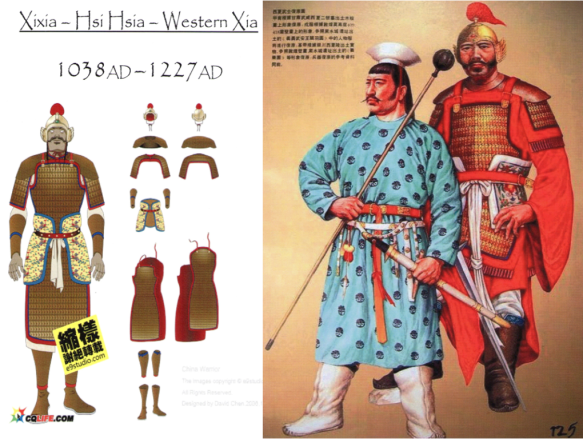Xia dynasty (Tangut, Xixia, Hsi-Hsia)
When Chinggis Khan united the Mongolian plateau by defeating the Kereyid and NAIMAN khanates in 1203–04, Ilqa-Senggüm, son of the Kereyid ONG KHAN, sought refuge in the Xia. After his adherents took to plundering the locals, however, he was expelled. Perhaps in response to the initial offer of refuge, Chinggis Khan in 1205 launched the first of his five campaigns against the Xia, plundering border settlements. In 1207 he sacked Wulahai, the main garrison along the Huang (Yellow) River in the northeast (near modern Wuyuan). In 1209 Chinggis undertook a larger campaign to secure the submission of the Xia. He again attacked Wulahai and followed the course of the Huang (Yellow) River up to the capital, Zhongxing (MARCO POLO’s Egrigaia). He attempted to flood the capital by diverting the river, but instead only flooded his own camp, thus ending the siege. Even so, the new and insecure Xia emperor, Li (Weiming) Anquan (r. 1206–11), agreed to present a daughter to Chinggis Khan together with a large tribute in which countless herds of CAMELS held pride of place. Chinggis Khan always required tributary powers to send hostages and to contribute troops to his campaigns, but the Xia resisted these demands. The Mongols left a garrison, probably at Wulahai, and the Xia Empire entered the Mongol orbit.
Sending troops and hostages proved to be sticking points in Xia-Mongol relations. As the Mongols invaded the neighboring JIN DYNASTY in 1211, the Xia took advantage to pursue long-standing border claims against the Jin. In 1218 the Mongols in North China invaded the Xia a fourth time. The Mongols besieged the capital again, and the Xia emperor Li (Weiming) Zunxu (r. 1211–23) fled west, leaving his son and officials to make peace. How the conflict was resolved is uncertain, but the Tanguts did not contribute soldiers the next year, when Chinggis Khan demanded men for his great western campaign against KHORAZM. Xia territory gave easy access to Shaanxi province, a vital area of remaining Jin control, so in 1221 MUQALI, the Mongol commander in North China, crossed the Huang (Yellow) River into Xia territory. Xia envoys promised 50,000 soldiers, which in the end never arrived, and Muqali had to retreat without subduing Shaanxi. After Muqali’s death in 1223 his Mongol and Chinese generals again raided the Xia.
When Chinggis Khan returned victorious from the conquest of Khorazm, he planned the final destruction of the recalcitrant Xia state. The campaign began in the northwest this time with the capture of Heishui (Khara- Khota, near modern Ejin Qi) in February–March 1226. The cities of the Gansu corridor were sacked one by one. Crossing the Huang (Yellow) River, the Mongols sacked Lingzhou near the capital in November, and on December 4 Chinggis Khan crossed back over the frozen Huang (Yellow) River to attack a relief column. The Mongols were victorious and besieged the capital. Confident the capital would fall, Chinggis Khan turned its capture over to his generals and left to attack the Jin cities along the Jin-Xia frontier in Gansu and Shaanxi. In July, when the last Xia ruler, Li Xian (r. 1226–27), finally surrendered, Chinggis Khan was on his deathbed to the south in Jin territory. After Chinggis’s death the Xia royal family and the population of Zhongxing were massacred.
TANGUTS IN THE MONGOL EMPIRE
Even before the fall of the Xia, a number of Mi-nyag, or Tangut, men had come into Mongol service. These were not Xia subjects, but Tanguts from the Jiu or Jüyin tribal auxiliaries enrolled by the Jin in Inner Mongolia. The Tangut Jiu rebelled early against the Jin and formed an important part of the Mongol armies in North China. The Tangut ethnic group survived the Mongol conquest, and the Tangut language was one of those used in the famous inscription at Juyongguan Pass in the 1340s. At first few Tanguts from the Xia region achieved high position. Under the class system of the Mongol YUAN DYNASTY after 1260, however, ethnic Tanguts were classified as SEMUREN (various sorts) and not as North Chinese, giving them an advantage in the exams. Thus, after 1300 Tangut officials achieved higher positions. The most important legacy of the Xia state to the Mongols was its patronage of Tibetan Buddhism, revived in 1240 by KÖTEN, a son of ÖGEDEI KHAN, who had received his appanage in the former Xia area.
Tangut captives dwelling among the Mongols were eventually assimilated into the Mongolian people. In the 16th century the Tangut formed one of the 14 clans of the Khalkha and are still widespread in Mongolia.
Further reading: Ruth Dunnell, “The Fall of the Xia Empire: Sino-Steppe Relations in the Late 12th–Early 13th Centuries,” in Rulers from the Steppe: State Formation on the Eurasian Periphery, ed. Gary Seaman and Daniel Marks (Los Angeles: Ethnographies Press, 1991), 158–185; Elliot Sperling, “Rtsa-mi Lo-ts-ba Sangs-rgyas Grags-pa and the Tangut Background to Early Mongol- Tibetan Relations,” in Tibetan Studies: Proceedings of the 6th Seminar of the International Association for Tibetan Studies, ed. Per Kvaerne (Oslo: Institute for Comparative Research in Human Culture, 1994), 2: 801–824.
